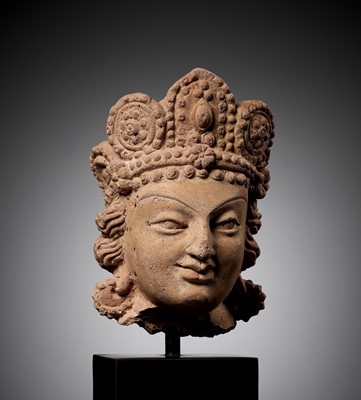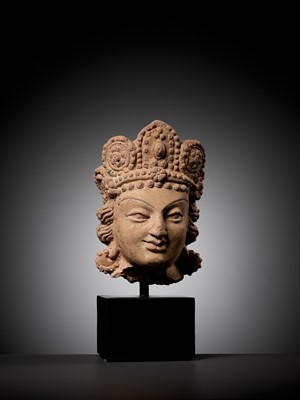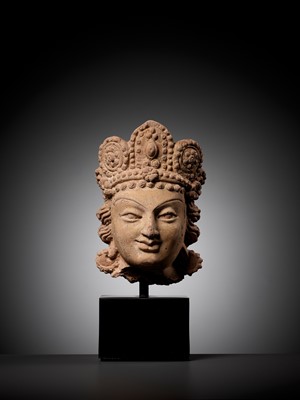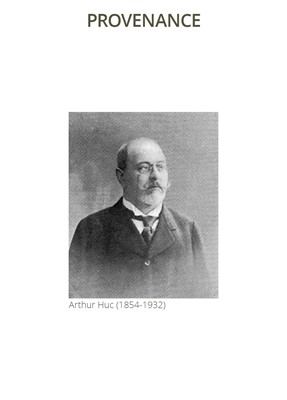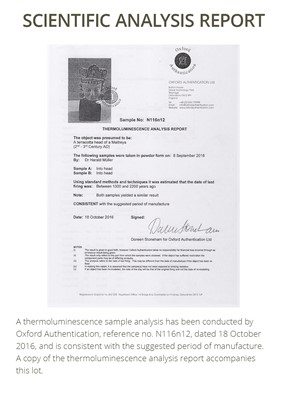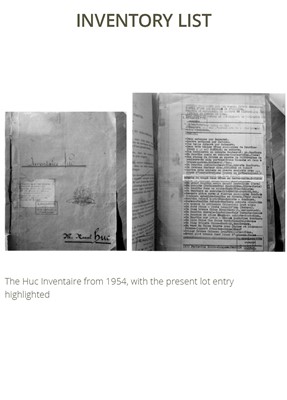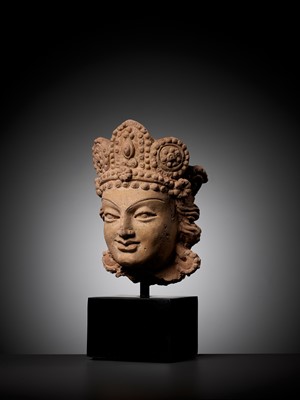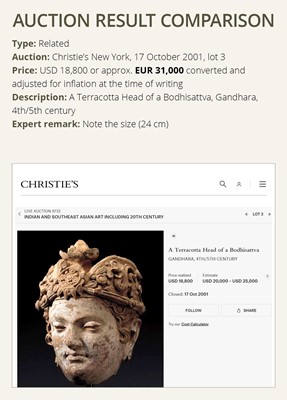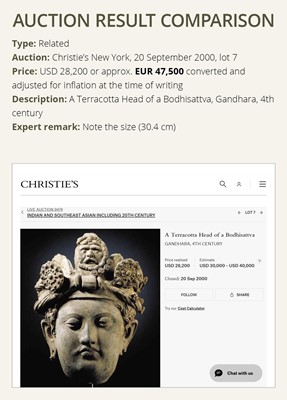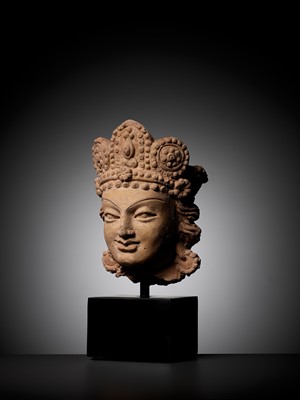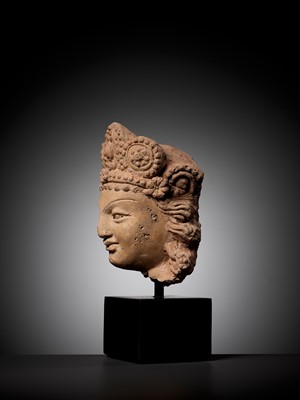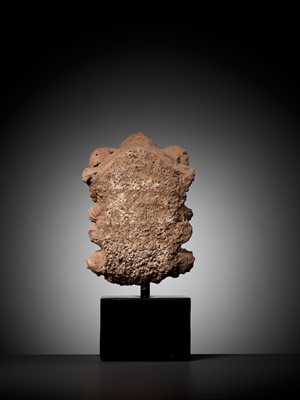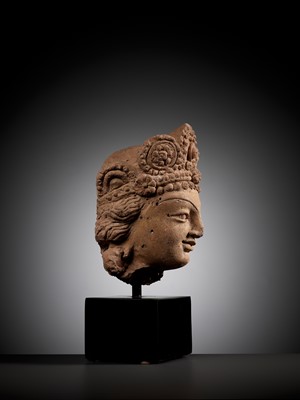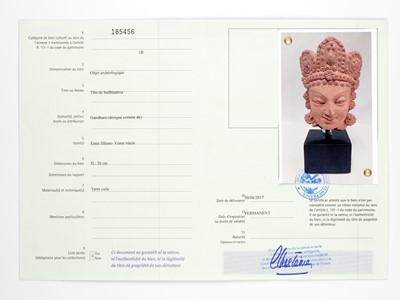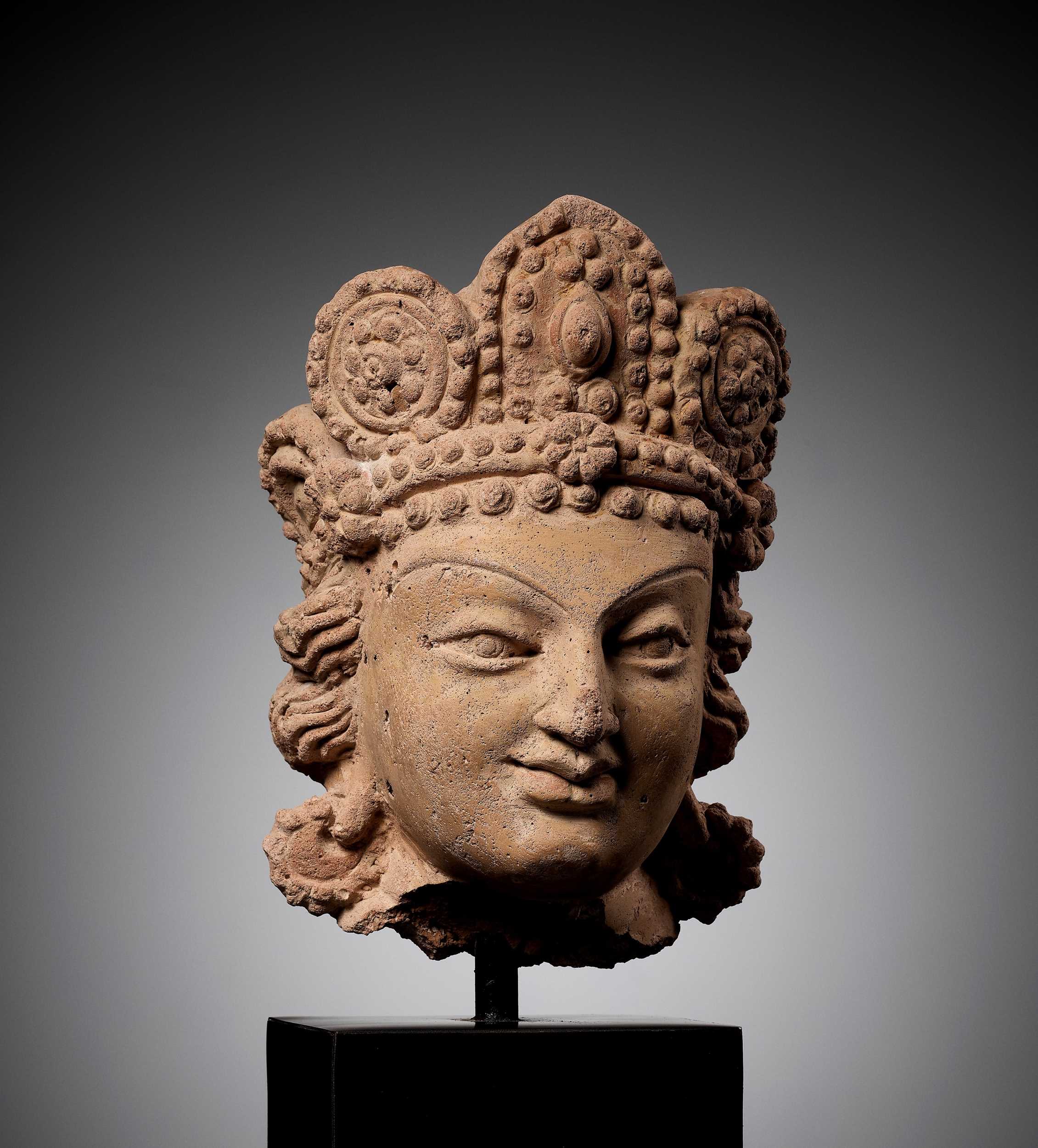30th Sep, 2022 10:00
DAY 2 - TWO-DAY AUCTION - Fine Chinese Art / 中國藝術集珍 / Buddhism & Hinduism
654
A TERRACOTTA HEAD OF MAITREYA, GANDHARA
犍陀羅紅陶彌勒頭像
Sold for €6,500
including Buyer's Premium
Ancient region of Gandhara, 4th-5th century. The head modeled with finely curled hair and wearing an elaborately adorned tiara centered by a stylized flower, the face with elegant features, such as the finely incised arched eyebrows, almond-shaped eyes, aquiline nose, gentle smile, and long earlobes with circular earrings.
Scientific Analysis Report: A thermoluminescence sample analysis has been conducted by Oxford Authentication, reference no. N116n12, dated 18 October 2016, and is consistent with the suggested period of manufacture. A copy of the thermoluminescence analysis report accompanies this lot.
Provenance: Arthur Huc (1854-1932). Marcel Huc, inherited from the above. Thence by descent within the same family. Arthur Huc was the chief editor of La Dépêche du Midi, at the time the leading newspaper in Toulouse, France. He was also an accomplished art critic and early patron of several artists, including Henri de Toulouse- Lautrec. At the same time, Arthur Huc was a keen collector of Asian art, a passion that he inherited from his legendary ancestor Évariste Régis Huc, also known as the Abbé Huc (1813-1860), a French Catholic priest and traveler who became famous for his accounts of Qing-era China, Mongolia and especially the then-almost-unknown Tibet in his book “Remembrances of a Journey in Tartary, Tibet, and China”.
Inventory List: In 1954, L. Magniette, bailiff of the court in Toulouse (Huissier), was ordered to compile a complete inventory of the collection inherited by Marcel Huc from his father, Arthur Huc, the so-called “Inventaire Huc”. The present lot is listed in this inventory as follows: “Serie de vingt deux têtes en terre-cuite. GANDHARA” (series of twenty-two terracotta heads. GANDHARA). A copy of the inventory list and cover page are accompanying this lot.
French Export License: Certificat d’exportation pour un bien culturel Nr. 185456 dated 30 June 2017 has been granted and a copy is accompanying this lot.
Condition: Excellent, almost unique condition, fully consistent with the age of the sculpture. Some firing flaws and material loss to exposed areas. Old wear, weathering, minor cracks and nicks.
Weight: 5.9 kg (incl. stand)
Dimensions: Height 28.5 cm (excl. stand) and 40.2 cm (incl. stand)
With a modern metal stand. (2)
The kingdom of Gandhara lasted from 530 BC to 1021 AD, when its last king was murdered by his own troops. It stretched across parts of present-day Afghanistan and Pakistan. Gandhara is noted for its distinctive style in Buddhist art, which developed out of a merger of Greek, Syrian, Persian and Indian artistic influences. Gandharan style flourished and achieved its peak during the Kushan period, from the 1st to the 5th century. In the first century AD, Gandhara was the birthplace of some of the earliest Buddhist images.
The use of hard-fired ceramic instead of stone such as schist became popular during the later Gandharan period from the 4th to 6th centuries AD. Fired clay was expensive in the area, because the wood needed for the firing process was scarce. Therefore, such an expensive sculpture would have been a highly meritorious Buddhist offering.
According to Buddhist tradition, Maitreya is a bodhisattva who will appear on Earth in the future, achieve complete enlightenment, and teach the pure dharma. According to scriptures, Maitreya will be a successor to the present Buddha. The prophecy of the arrival of Maitreya refers to a time in the future when the dharma will have been forgotten by most on the terrestrial world. In the Greco-Buddhist art of Gandhara, in the first centuries CE in northern India, Maitreya was the most popular figure to be represented along with Gautama Buddha.
Auction result comparison:
Type: Related
Auction: Christie’s New York, 17 October 2001, lot 3
Price: USD 18,800 or approx. EUR 31,000 converted and adjusted for inflation at the time of writing
Description: A Terracotta Head of a Bodhisattva, Gandhara, 4th/5th century
Expert remark: Note the size (24 cm)
Auction result comparison:
Type: Related
Auction: Christie’s New York, 20 September 2000, lot 7
Price: USD 28,200 or approx. EUR 47,500 converted and adjusted for inflation at the time of writing
Description: A Terracotta Head of a Bodhisattva, Gandhara, 4th century
Expert remark: Note the size (30.4 cm)
犍陀羅紅陶彌勒頭像
犍陀羅,四至五世紀。頭飾捲曲,佩戴著五葉冠,細長眉,杏仁形眼睛,鼻梁高挺,面帶微笑,長耳垂佩戴圓形耳環,面容慈祥溫和。
科學檢測報告:牛津鑒定研究所熱釋光報告編號N116n12,2016年10月18日,得出相關製作時間。隨附報告複印件。
來源:Arthur Huc (1854-1932)收藏。Marcel Huc繼承,自此保存在同一家族至今。Arthur Huc 是 La Dépêchedu Midi的主編,這是當時法國圖盧茲的主要報紙。他還是一位出色的藝術評論家,也是包括Henri de Toulouse- Lautrec在內的幾位藝術家的早期贊助人。同時,Arthur Huc是一位熱衷於亞洲藝術的收藏家,他的熱情源於他的傳奇祖先Évariste Régis Huc,中文名為古伯察(1813-1860),是法國天主教神父和旅行作家,在他的《韃靼西藏旅行記》書中描述了他在清朝的遊歷以及對蒙古尤其是當時幾乎鮮為人知的西藏的敘述。
收藏清單:1954年,圖盧茲法院法警 L. Magniette奉命對Marcel Huc從其父親Arthur Huc繼承的收藏品進行完整目錄彙編,即所謂的“ Inventaire Huc”。此拍品也在當時列出的收藏清單中“ Serie de vingt deuxtêtesen terre-cuite。GANDHARA”(二十二個陶土頭像系列,犍陀羅)。隨附清單和封面副本。
法國出口證書:隨附2017年6月30日出具的Certificat d’exportation pour un bien culturel 證書的複本,編號 185465。
品相:狀況極好,與雕塑的年代相符。一些燒製缺陷和暴露區域的材料缺損。磨損、風化、輕微裂縫和刻痕。
重量:5.9 公斤 (含底座)
尺寸:高28.5 厘米 (不含底座) ,總40.2 厘米 (含底座)
現代金屬支架。
犍陀羅王國從公元前 530 年持續到公元 1021 年最後一位國王被自己的軍隊殺害。 它橫跨今天的阿富汗和巴基斯坦的部分地區。犍陀羅以其獨特的佛教藝術風格而聞名于世,這種風格融合了希臘、敘利亞、波斯和印度的藝術影響。犍陀羅風格在一世紀至五世紀的貴霜時期達到頂峰。在公元一世紀,犍陀羅是早期佛教造像的發源地。
在公元四至六世紀末的犍陀羅時期,使用硬燒陶器代替片岩、大理石或砂岩等石頭開始流行。燒製粘土在該地區很昂貴,因為燒製過程所需的木材稀缺。 所以,這麼大型的佛像,本來就是一件極有功德的供品。只有少數這個時期的這麽大尺寸的陶像有記錄可循。
彌勒佛是釋迦牟尼佛的繼任者,將在未來娑婆世界降生成佛,將從兜率天降到人間,他右手掌上舉,左手朝下,意謂阿彌陀佛自淨土下生,救助眾生,接引極樂世界。在公元一世紀的印度北部,在犍陀羅的希臘風格佛教藝術中,彌勒佛與釋迦牟尼佛極其受歡迎。
拍賣結果比較:
形制:相近
拍賣:紐約佳士得,2001年10月17日,lot 3
價格:USD 18,800(相當於今日EUR 31,000)
描述:四至五世紀犍陀羅紅陶菩薩頭像
專家評論:請注意尺寸(24 厘米)。
拍賣結果比較:
形制:相近
拍賣:紐約佳士得,2000年9月20日,lot 7
價格:USD 28,200(相當於今日EUR 47,500)
描述:四世紀犍陀羅紅陶菩薩頭像
專家評論:請注意尺寸(30.4 厘米)。
Ancient region of Gandhara, 4th-5th century. The head modeled with finely curled hair and wearing an elaborately adorned tiara centered by a stylized flower, the face with elegant features, such as the finely incised arched eyebrows, almond-shaped eyes, aquiline nose, gentle smile, and long earlobes with circular earrings.
Scientific Analysis Report: A thermoluminescence sample analysis has been conducted by Oxford Authentication, reference no. N116n12, dated 18 October 2016, and is consistent with the suggested period of manufacture. A copy of the thermoluminescence analysis report accompanies this lot.
Provenance: Arthur Huc (1854-1932). Marcel Huc, inherited from the above. Thence by descent within the same family. Arthur Huc was the chief editor of La Dépêche du Midi, at the time the leading newspaper in Toulouse, France. He was also an accomplished art critic and early patron of several artists, including Henri de Toulouse- Lautrec. At the same time, Arthur Huc was a keen collector of Asian art, a passion that he inherited from his legendary ancestor Évariste Régis Huc, also known as the Abbé Huc (1813-1860), a French Catholic priest and traveler who became famous for his accounts of Qing-era China, Mongolia and especially the then-almost-unknown Tibet in his book “Remembrances of a Journey in Tartary, Tibet, and China”.
Inventory List: In 1954, L. Magniette, bailiff of the court in Toulouse (Huissier), was ordered to compile a complete inventory of the collection inherited by Marcel Huc from his father, Arthur Huc, the so-called “Inventaire Huc”. The present lot is listed in this inventory as follows: “Serie de vingt deux têtes en terre-cuite. GANDHARA” (series of twenty-two terracotta heads. GANDHARA). A copy of the inventory list and cover page are accompanying this lot.
French Export License: Certificat d’exportation pour un bien culturel Nr. 185456 dated 30 June 2017 has been granted and a copy is accompanying this lot.
Condition: Excellent, almost unique condition, fully consistent with the age of the sculpture. Some firing flaws and material loss to exposed areas. Old wear, weathering, minor cracks and nicks.
Weight: 5.9 kg (incl. stand)
Dimensions: Height 28.5 cm (excl. stand) and 40.2 cm (incl. stand)
With a modern metal stand. (2)
The kingdom of Gandhara lasted from 530 BC to 1021 AD, when its last king was murdered by his own troops. It stretched across parts of present-day Afghanistan and Pakistan. Gandhara is noted for its distinctive style in Buddhist art, which developed out of a merger of Greek, Syrian, Persian and Indian artistic influences. Gandharan style flourished and achieved its peak during the Kushan period, from the 1st to the 5th century. In the first century AD, Gandhara was the birthplace of some of the earliest Buddhist images.
The use of hard-fired ceramic instead of stone such as schist became popular during the later Gandharan period from the 4th to 6th centuries AD. Fired clay was expensive in the area, because the wood needed for the firing process was scarce. Therefore, such an expensive sculpture would have been a highly meritorious Buddhist offering.
According to Buddhist tradition, Maitreya is a bodhisattva who will appear on Earth in the future, achieve complete enlightenment, and teach the pure dharma. According to scriptures, Maitreya will be a successor to the present Buddha. The prophecy of the arrival of Maitreya refers to a time in the future when the dharma will have been forgotten by most on the terrestrial world. In the Greco-Buddhist art of Gandhara, in the first centuries CE in northern India, Maitreya was the most popular figure to be represented along with Gautama Buddha.
Auction result comparison:
Type: Related
Auction: Christie’s New York, 17 October 2001, lot 3
Price: USD 18,800 or approx. EUR 31,000 converted and adjusted for inflation at the time of writing
Description: A Terracotta Head of a Bodhisattva, Gandhara, 4th/5th century
Expert remark: Note the size (24 cm)
Auction result comparison:
Type: Related
Auction: Christie’s New York, 20 September 2000, lot 7
Price: USD 28,200 or approx. EUR 47,500 converted and adjusted for inflation at the time of writing
Description: A Terracotta Head of a Bodhisattva, Gandhara, 4th century
Expert remark: Note the size (30.4 cm)
犍陀羅紅陶彌勒頭像
犍陀羅,四至五世紀。頭飾捲曲,佩戴著五葉冠,細長眉,杏仁形眼睛,鼻梁高挺,面帶微笑,長耳垂佩戴圓形耳環,面容慈祥溫和。
科學檢測報告:牛津鑒定研究所熱釋光報告編號N116n12,2016年10月18日,得出相關製作時間。隨附報告複印件。
來源:Arthur Huc (1854-1932)收藏。Marcel Huc繼承,自此保存在同一家族至今。Arthur Huc 是 La Dépêchedu Midi的主編,這是當時法國圖盧茲的主要報紙。他還是一位出色的藝術評論家,也是包括Henri de Toulouse- Lautrec在內的幾位藝術家的早期贊助人。同時,Arthur Huc是一位熱衷於亞洲藝術的收藏家,他的熱情源於他的傳奇祖先Évariste Régis Huc,中文名為古伯察(1813-1860),是法國天主教神父和旅行作家,在他的《韃靼西藏旅行記》書中描述了他在清朝的遊歷以及對蒙古尤其是當時幾乎鮮為人知的西藏的敘述。
收藏清單:1954年,圖盧茲法院法警 L. Magniette奉命對Marcel Huc從其父親Arthur Huc繼承的收藏品進行完整目錄彙編,即所謂的“ Inventaire Huc”。此拍品也在當時列出的收藏清單中“ Serie de vingt deuxtêtesen terre-cuite。GANDHARA”(二十二個陶土頭像系列,犍陀羅)。隨附清單和封面副本。
法國出口證書:隨附2017年6月30日出具的Certificat d’exportation pour un bien culturel 證書的複本,編號 185465。
品相:狀況極好,與雕塑的年代相符。一些燒製缺陷和暴露區域的材料缺損。磨損、風化、輕微裂縫和刻痕。
重量:5.9 公斤 (含底座)
尺寸:高28.5 厘米 (不含底座) ,總40.2 厘米 (含底座)
現代金屬支架。
犍陀羅王國從公元前 530 年持續到公元 1021 年最後一位國王被自己的軍隊殺害。 它橫跨今天的阿富汗和巴基斯坦的部分地區。犍陀羅以其獨特的佛教藝術風格而聞名于世,這種風格融合了希臘、敘利亞、波斯和印度的藝術影響。犍陀羅風格在一世紀至五世紀的貴霜時期達到頂峰。在公元一世紀,犍陀羅是早期佛教造像的發源地。
在公元四至六世紀末的犍陀羅時期,使用硬燒陶器代替片岩、大理石或砂岩等石頭開始流行。燒製粘土在該地區很昂貴,因為燒製過程所需的木材稀缺。 所以,這麼大型的佛像,本來就是一件極有功德的供品。只有少數這個時期的這麽大尺寸的陶像有記錄可循。
彌勒佛是釋迦牟尼佛的繼任者,將在未來娑婆世界降生成佛,將從兜率天降到人間,他右手掌上舉,左手朝下,意謂阿彌陀佛自淨土下生,救助眾生,接引極樂世界。在公元一世紀的印度北部,在犍陀羅的希臘風格佛教藝術中,彌勒佛與釋迦牟尼佛極其受歡迎。
拍賣結果比較:
形制:相近
拍賣:紐約佳士得,2001年10月17日,lot 3
價格:USD 18,800(相當於今日EUR 31,000)
描述:四至五世紀犍陀羅紅陶菩薩頭像
專家評論:請注意尺寸(24 厘米)。
拍賣結果比較:
形制:相近
拍賣:紐約佳士得,2000年9月20日,lot 7
價格:USD 28,200(相當於今日EUR 47,500)
描述:四世紀犍陀羅紅陶菩薩頭像
專家評論:請注意尺寸(30.4 厘米)。
Zacke Live Online Bidding
Our online bidding platform makes it easier than ever to bid in our auctions! When you bid through our website, you can take advantage of our premium buyer's terms without incurring any additional online bidding surcharges.
To bid live online, you'll need to create an online account. Once your account is created and your identity is verified, you can register to bid in an auction up to 12 hours before the auction begins.
Intended Spend and Bid Limits
When you register to bid in an online auction, you will need to share your intended maximum spending budget for the auction. We will then review your intended spend and set a bid limit for you. Once you have pre-registered for a live online auction, you can see your intended spend and bid limit by going to 'Account Settings' and clicking on 'Live Bidding Registrations'.
Your bid limit will be the maximum amount you can bid during the auction. Your bid limit is for the hammer price and is not affected by the buyer’s premium and VAT. For example, if you have a bid limit of €1,000 and place two winning bids for €300 and €200, then you will only be able to bid €500 for the rest of the auction. If you try to place a bid that is higher than €500, you will not be able to do so.
Online Absentee and Telephone Bids
You can now leave absentee and telephone bids on our website!
Absentee Bidding
Once you've created an account and your identity is verified, you can leave your absentee bid directly on the lot page. We will contact you when your bids have been confirmed.
Telephone Bidding
Once you've created an account and your identity is verified, you can leave telephone bids online. We will contact you when your bids have been confirmed.
Classic Absentee and Telephone Bidding Form
You can still submit absentee and telephone bids by email or fax if you prefer. Simply fill out the Absentee Bidding/Telephone bidding form and return it to us by email at office@zacke.at or by fax at +43 (1) 532 04 52 20. You can download the PDF from our Upcoming Auctions page.
How-To Guides
How to Create Your Personal Zacke Account
How to Register to Bid on Zacke Live
How to Leave Absentee Bids Online
How to Leave Telephone Bids Online
中文版本的操作指南
创建新账号
注册Zacke Live在线直播竞拍(免平台费)
缺席投标和电话投标
Third-Party Bidding
We partner with best-in-class third-party partners to make it easy for you to bid online in the channel of your choice. Please note that if you bid with one of our third-party online partners, then there will be a live bidding surcharge on top of your final purchase price. You can find all of our fees here. Here's a full list of our third-party partners:
- 51 Bid Live
- EpaiLive
- ArtFoxLive
- Invaluable
- LiveAuctioneers
- the-saleroom
- lot-tissimo
- Drouot
Please note that we place different auctions on different platforms. For example, in general, we only place Chinese art auctions on 51 Bid Live.
Bidding in Person
You must register to bid in person and will be assigned a paddle at the auction. Please contact us at office@zacke.at or +43 (1) 532 04 52 for the latest local health and safety guidelines.
